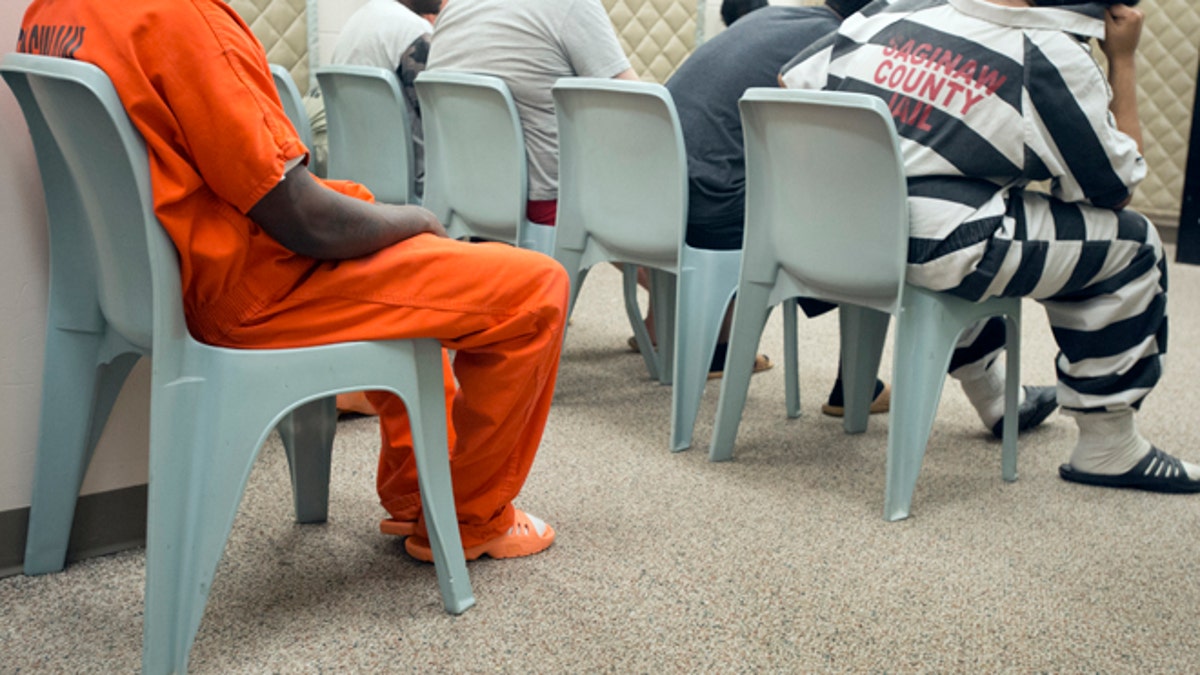
Inmates wait for their video arraignments at the Saginaw County Jail, Friday, July 18, 2014. The Saginaw County Sheriff's Department has purchased new jumpsuits, with black and white stripes, for some of the inmates at the jail. (AP Photo/The Saginaw News/MLive.com, Jeff Schrier) (AP Photo/The Saginaw News/MLive.com, Jeff Schrier)
Right now, more than two million people in the United States are behind bars. This is a human tragedy, but it is also a crisis with far-reaching consequences for communities across America.
A recent White House report shows that the economic, social, and human costs of mass incarceration have never been higher. Beyond the staggering $270 billion that the U.S. spends on the criminal justice system annually, incarceration tears apart families, deepens poverty, and fuels mistrust of our vital public institutions. A problem this big clearly demands urgent action.
For years now, we have waited for Congress to act or other branches of the federal government to take steps to reduce mass incarceration.
Conventional wisdom says there is momentum for change and for significant bipartisan action on criminal justice reform. But progress toward meaningful reform at the national level has been agonizingly slow. Despite a growing chorus of voices for change across the aisle, Congress has failed to pass sentencing reform legislation or any other major improvements to our justice system this year.
Jail time separates people—most of whom haven’t been convicted of a crime—from their families, increases the likelihood of re-offense, reduces employment opportunities, and drains community resources that could be more productively invested.
If we want to make a real impact in ending over-incarceration, we must look beyond Congress and the White House. Reforms at the local level—where jails increasingly serve as a gateway to mass incarceration and recent progress shows that change is possible—may offer the greatest opportunity to make a lasting impact. Local jails are largely missing from the national conversation about mass incarceration, but they are where the problem begins.
Twelve million people are admitted to America’s jails every year, almost 20 times as many as are to state and federal prisons. Jails are intended primarily to hold those who pose a flight risk or threat to public safety.
Given our national over-reliance on incarceration, jails now warehouse thousands of people for nonviolent offenses, many solely because they are too poor to post bail.
In New York City in 2012, for example, nearly a third of non-felony defendants confined to jail until their cases were resolved were being held on bails of less than $500.
Astonishingly, three-quarters of people in jail are there for nonviolent traffic, drug, property or public order offenses.
We need to ask ourselves if this is the best use of our public resources and our justice system.
The misuse of jails contributes in many ways to our country’s incarceration rate. Spending just two days in a local jail quadruples the chances that a person will ultimately land in a state or federal prison, according to research from the Arnold Foundation.
Jail time separates people—most of whom haven’t been convicted of a crime—from their families, increases the likelihood of re-offense, reduces employment opportunities, and drains community resources that could be more productively invested.
It is no surprise that these issues take a heavier toll on some communities than others. Racial and ethnic disparities in jail populations can be found in local justice systems across the country. While African-Americans and Latinos make up 30 percent of Americans, they comprise 51 percent of the U.S. jail population.
Many jails have become warehouses for people suffering from serious mental illness and substance abuse issues, largely because there are insufficient community-based services to meet their needs.
Instead of making us safer, jail misuse negatively impacts public safety. Research shows that even people who are detained in jail for a relatively short stay before trial are more likely to be rearrested before their trial or commit a crime after completing their sentence.
With annual spending on the building and running of jails currently four times what it was in the early 1980s, and the social cost immeasurably higher, we must ask ourselves: What are we paying for? Isn’t there a better, more just and productive path?
Encouraging efforts around the country show that there is. New Orleans, a city that once claimed the highest jail incarceration rate in the country, has cut its jail population by two-thirds in the last decade.
By replacing the jail Hurricane Katrina destroyed with a much smaller jail and instituting pretrial risk assessment, New Orleans has demonstrated how local justice systems can promote better outcomes and increase fairness while ensuring public safety. And in New York City, Brooklyn’s district attorney has made the bold decision to stop prosecuting most people arrested on low-level marijuana charges, helping keep many people out of jail who don’t pose a safety or flight risk and protecting their ties to employment, family, and community.
To spur innovations and effective reforms like these, the MacArthur Foundation, is supporting jurisdictions across the country as they work to create fairer, more effective local justice systems.
Our hope is that their work, supported through our Safety and Justice Challenge, will provide successful models and inspire new solutions for ending the misuse of jails in the United States. As part of the initiative, 11 U.S. cities and counties—including New Orleans and New York City—recently announced efforts to create alternatives to incarceration and cut their jail populations by up to one-third.
Just because Congress is failing to act does not mean everyone is. There is growing momentum behind bold reforms at the local level that can reduce over-incarceration in America.
We have the opportunity to close the front door to this crisis—and we cannot let it pass us by.
